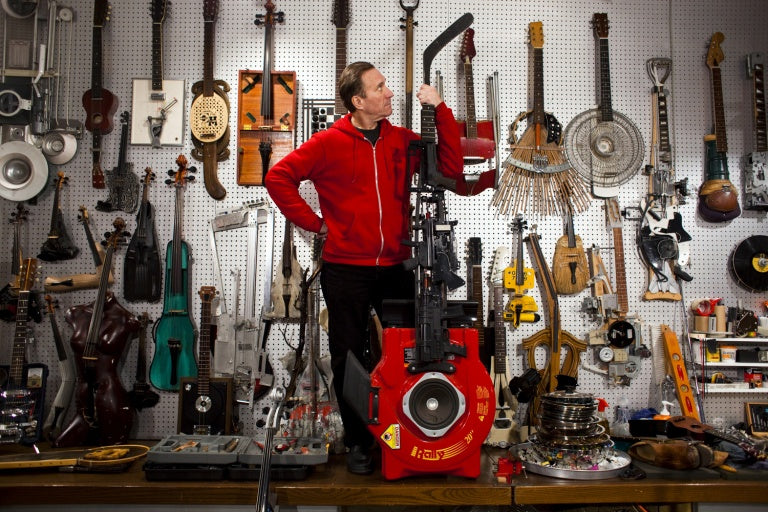Ken Butler

Ken Butler is an artist and musician whose Hybrid musical instruments, performances and other works explore the interaction and transformation of common and uncommon objects, altered images, and sounds as function and form collide in the intersection of art and music.
Butler is internationally recognized as an innovator of experimental musical instruments created from diverse materials including tools, sports equipment, and household objects. The idea of bricolage, essentially using whatever is “at hand”, is at the center of his art, encompassing a wide range of practice that combines assemblage art, live music, instrument design, performance art, theater, sculpture, installation, photography, film/video, graphic design, drawing, and collage.
Biography
Ken Butler studied viola as a child and maintained an interest in music while studying visual arts in France, at Colorado College, and Portland State University where he completed his MFA in painting.
He has been featured in exhibitions and performances worldwide including The Stedelijk Museum in Amsterdam, The Prada Foundation in Venice (as part of the “Art or Sound” exhibition at the Venice Biennale in 2014), The State Hermitage Museum in St. Petersburg, Mass Moca, and The Kitchen, The Brooklyn Museum, Lincoln Center and The Metropolitan Museum in New York City as well as in Canada, South America, Thailand, and Japan.
His works have been reviewed in The New York Times, The Village Voice, Artforum, Smithsonian, and Sculpture Magazine and have been featured on PBS, CNN, MTV, and NBC, including a live appearance on The Tonight Show. Awards include fellowships from the Oregon Arts Commission, the New York Foundation for the Arts, the National Endowment for the Arts, and the Pollack/Krasner Foundation. He won first prize in the 2016 international Guthman Musical Instrument Competition at Georgia Tech University.
Butler has performed with John Zorn, Laurie Anderson, David Van Tieghem, Butch Morris, The Soldier String Quartet, Matt Darriau’s Paradox Trio, The Tonight Show Band, and The Master Gnawa musicians of Morocco. His CD, Voices of Anxious Objects is on Tzadik records.
Works by Ken Butler are represented in public and private collections in Portland, Seattle, Vail, Los Angeles, Toronto, Montreal, Washington, Paris, Tel Aviv, and New York City including the permanent collection of The Metropolitan Museum of Art. He resides in Brooklyn, New York.
Ken Butler: Background
At the time I created my first hybrid instrument quite by accident in 1978 by adding a fingerboard, tailpiece, pegs, bridge, and contact microphone to a small hatchet which I then played as a violin, I was working in a variety of primarily visual media including painting, photo/collage, film and slide animation, and inter-active sculpture/light installations. The axe-violin, which I have played at hundreds of live performances was both my first sound piece and sculptural object and further created the fusion of art forms and conceptual framework I was seeking – a transformative and poetic bricolage of form and function and cultural identity. Since that time I have created over 400 hybrid string (and a few percussion) instruments/sculptures from primarily found objects and materials, numerous inter-active sound and light installations, assemblage works, and live performances ranging from solo concerts to large-scale multi-media events with text, instrument-controlled multiple slide and kinetic shadow projections, and live music played on hybrid instruments by several artist/musicians.
The origin of the first Hybrid Instrument
The path to the creation of my first hybrid instrument and ultimately performance work was begun in the mid-70’s while working with contact printing full torso x-rays onto light-sensitive diazo paper used by architects. The resulting images were extremely guitar-like (vertebrae as frets, and neck, etc.) and were used as a backdrop for a large wall installation utilizing an actual guitar and violin. Entitled “Harmony on the Critical List”, the work had a musical/medical theme as well as dada-futuro-cubist qualities. As I was already musically involved with string instruments, I then began to think of the ergonomic and proportional relationship they bear to the human body.
In 1978 I was in my basement when I saw a small hatchet left by a former tenant. Something compelled me to pull it up under my chin as though it were a violin. Immediately I imagined it as a fully functional instrument and went upstairs to see if it would perchance fit into a violin case, which it did perfectly. I fitted a fingerboard, tailpiece, pegs, bridge, and contact microphone to the axe and was quite amazed when it sounded remarkably good played though my guitar amplifier. So I could really play my “axe”. I was unaware at the time of the profound effect of this creation on my artistic life, initiating the idea of live performance. The Axe violin was both my first sound piece as well as sculptural object and further created the fusion of art forms I was seeking – a transformative bricolage or hybridization of form and function and cultural object identity.
Artist Statement
Contemporary urban life is a bewildering collage of multiple images, ideas, sounds, and objects in a constant state of flux as information overload becomes the touchstone of our age. As we move from the mechanical to the electronic, this churning mass chews up and spits out material with re-assigned priorities and updates. The resulting detritus is a living corpse – a random and chaotic body of juxtaposed and deconstructed items and associations. From this storehouse of forsaken objects and hardware I, the urban bricoleur, further dismantle and reassemble the consumer society into assemblages in the form of musical instrument/objects, then at times coax some of them them to sing for their supper.
Ken Butler’s Hybrid Visions
Characterized by his obsessive desire to re-order the world around him, Butler’s multi-disciplinary creations can be difficult to describe as they bridge visual art, design, performance, and life itself in unusual ways. Ever the urban bricoleur, the artist is a resourceful improviser committed to exploring and re-imagining our relationships to the objects around us.









































